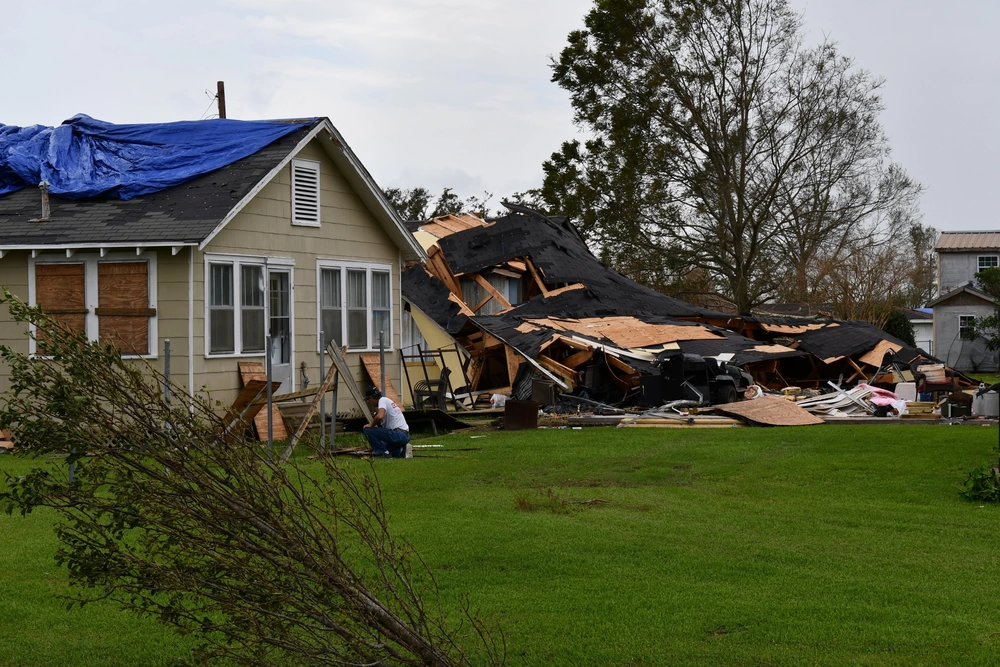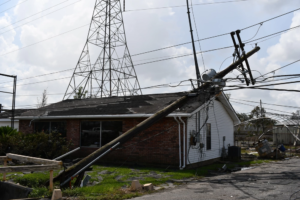
Hurricane Ida’s wrath on Louisiana
Kevin Baxter | Staff Reporter
On August 29, 2021, the 16th anniversary of Hurricane Katrina, Hurricane Ida hit Louisiana. Governor John Bel Edwards predicted it to be “one of the strongest hurricanes to hit Louisiana since the 1850s” during a press conference the day before.
The appearance of U.S. Department of Defense (DoD) visual information does not imply or constitute DoD endorsement.One week after the storm’s initial landfall, more than half a million Louisianans are still without power, and the Louisiana Department of Health’s death count has risen to 10. On Saturday, August 28, at 2 p.m. on Facebook Live, Gov. Edwards held a conference, updating the nation on Louisiana’s response to the incoming Category 4 hurricane. Gov. Edwards urged Louisianans to prepare when he said, “Your window of time is closing. It is rapidly closing. By the time you go to bed tonight, you need to be where you intend to ride this storm out.”
The next day, as Hurricane Ida’s 150 mph winds had drawn closer and begun to move ashore near Port Fourchon, President Joe Biden approved Gov. Edwards’ request for a Presidential major disaster declaration. According to FEMA’s fact sheet on the disaster declaration process, “a major disaster declaration provides a wide range of federal assistance programs for individuals and public infrastructure, including funds for both emergency and permanent work.”
As the storm slowly moved through Louisiana, it left more than 900,000 households without power and ripped the rooftops from buildings. The earliest deaths attributed to the storm were from a tree falling onto a 60-year-old man’s home and another man drowning while attempting to drive through floodwaters.
One week after Ida’s landfall, ten deaths have been attributed to the storm by the Louisiana Department of Health. Three of those deaths are due to carbon monoxide poisoning, the number one killer during storm events in 2020. According to the LDH, one should “only use a generator in a well-ventilated area and place away from structures, at least 20 feet away from your home, windows, and doors.”
As Ida continued through Louisiana, the storm began to weaken but still held strong. By 6 p.m. on August 29, Ida was still considered a Category 4 hurricane with maximum winds of 130 mph. Around 8 p.m., Ida had been downgraded to a Category 3 storm, yet still packed strong sustained winds of 125 mph and was moving northwest at a speed of 10 mph. Then as Ida moved inland through the night, it continued to weaken and was, again, downgraded to a strong Category 2 hurricane with sustained winds of 110 mph. By Monday, August 30, Ida had been declared a tropical depression over Mississippi.

Many of those affected by the storm sought refuge in Houston; one specific shelter is Gallery Furniture, run by Jim ‘Mattress Mack’ McIngvale. McIngvale offered free shelter to anyone with a Louisiana ID at Gallery Furniture in Houston. He also loaded up a convoy of trucks to bring donated food, water, and supplies into Louisiana. McIngvale has a history of providing aid during disasters such as Hurricane Ida. He turned his stores into shelters during Hurricane Katrina, Hurricane Harvey, Tropical Storm Imelda, and through the severe winter storm that hit Texas earlier this year.
On McIngvale’s Facebook page, there’s a video detailing Gallery Furniture’s relief efforts with the community. Throughout the video, you can also hear stories from evacuees staying at Gallery Furniture, such as one from a pregnant mother, Anna, describing the horror of experiencing their house crumble before them.
“We literally sat in our window watching every fence near and on our house just fly away,” Anna said. “Then the whole wall literally just cracked. I was like, oh my goodness. At that point, I was like, ‘Get in the hallway,’ then the hallway started leaking too. And I’m not really much help right now in this position, being pregnant. The minute we got out the way, the whole kitchen ceiling went woosh and hit the floor. We’re not vaccinated. So that’s my biggest fear, is that one of either me or my children or him all get sick, especially during this time, I mean, we’re not home, so it makes it even worse.”
Luckily, families whose homes were destroyed by the hurricane can have a place to sleep, eat, and reconvene after what has happened, thanks to Gallery Furniture and the Houston community. Gallery Furniture is still accepting donations online for food and items to bring to those in Louisiana.
One concern that arises with crowding shelters and displaced citizens is that of COVID-19. According to Johns Hopkins University, Louisiana had seen a dramatic spike in COVID-19 during the second week of August that gradually diminished through the month. However, starting September 2, there already seems to be a sharp increase in positive cases and deaths. On top of that, Louisiana is also one of the least vaccinated states, with only 42.15% of the population fully vaccinated.
Gov. Edwards had discussed COVID-19 numbers during his press conference on August 28. According to Gov. Edwards, individuals hospitalized due to COVID-19 had dropped by about 20% over the past ten days to 2,450 individuals. Although Gov. Edwards was thankful for the drop, he added that the number of individuals hospitalized is still higher than during the last three surges prior to the current fourth surge. The governor believes it will take time to understand what effects Hurricane Ida will have on the pandemic.
Texas State University offers emergency funding to students who are faced with financial trouble after an emergency event. On their Twitter page, the university said those affected by the storm could apply for emergency funding from the university that provides $100 to $500 per student, depending on the funding source. The university also offered its counseling services to students affected by the storm.
APPLY FOR DISASTER ASSISTANCE FROM FEMA
If you or your friends and family were impacted by Hurricane Ida and are in one of the communities approved for individual assistance from FEMA, you can apply for disaster assistance. Go to disasterassistance.gov or call 1-800-621-3362 from 7 a.m. to 11 p.m. ET seven days a week.






